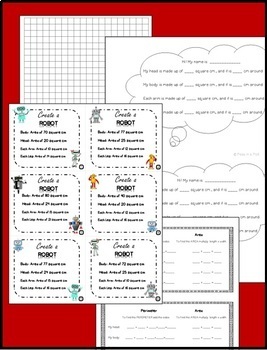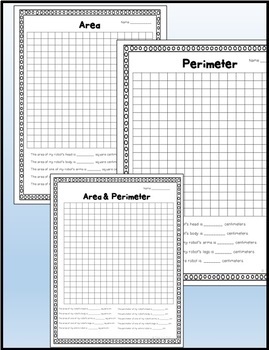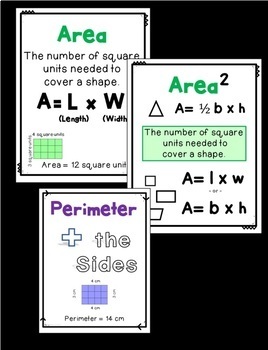May Craft Area and Perimeter End of Year Math Project Review Activities 4th 5th
- PDF
What educators are saying
Description
Check out this fun 4th and 5th grade math review! Students love creating their area and perimeter robot! In the first activity, students create model robots that have specified area or perimeter by cutting up the 1 square cm grid paper provided. Students are able to create their own robots and find the area of each body part by using either multiplication, repeated addition, or counting square units!
✅ Easy Differentiation: ✅
If you’d like to make it more challenging, I’ve included 6 different task cards with specific area measurements for students to re-create. A photo example is included, as well as three similar area & perimeter 1 page activities that can be done without cutting and pasting.
✅ Excellent Bulletin Board Displays ✅
I ask students to use only squares & rectangles for arms, legs, & head, but allow them to get creative when coloring them. I also use 18 x12 construction paper down to 16 x 10 so we can display more robots on the bulletin board.
✨ TEACHERS LIKE YOU HAVE SAID…✨
⭐️⭐️⭐️⭐️⭐️ Catherine H. said, “This is wonderful! It's perfect hands-on practice. It is easily differentiated, and the variety of robot designs my students created was impressive!!”
⭐️⭐️⭐️⭐️⭐️ Tyler M. said, "The kids enjoyed this project so much! It was helpful to review area and perimeter and aligned very well with the standards for the school wide bulletin boards!
► Common Core ►
3.MD.C.5, 3.MD.C.5a, 3.MD.C.5b, 3.MD.C.6, 3.MD.C.7, 3.MD.C.7a, 3.MD.C.7b, 3.MD.D.8, 3.MD.C.7d 4.MD.A.3
◼️ If you like this, you might also like the links below:◼️
Back 2 School Pack {Intermediate}
Writing ~ Response to Literature!
Click Here for an Awesome Reading Fluency Graph
Click here for Handy Dandy Student Reference Divisibility Rules
✏️ Connect with Peas in a Pod Lessons! ✏️
THANK YOU!
Melissa (Peas in a Pod)
Copyright: Copying any part of this product and placing it on the internet in any form (even personal/class website) is forbidden and is a violation of the Digital Millennium Copyright Act (DMCA). In purchasing this resource, you are agreeing that the contents are the property of Peas in a Pod and licensed to you only for classroom/personal use as a single user. I retain the copyright, and reserve all rights to this product. Thank you!





